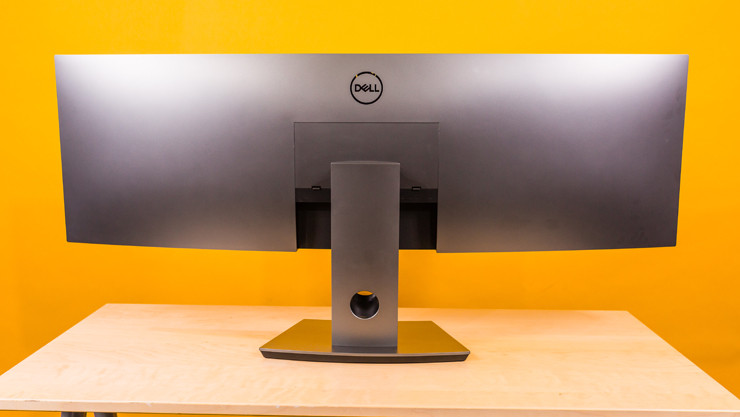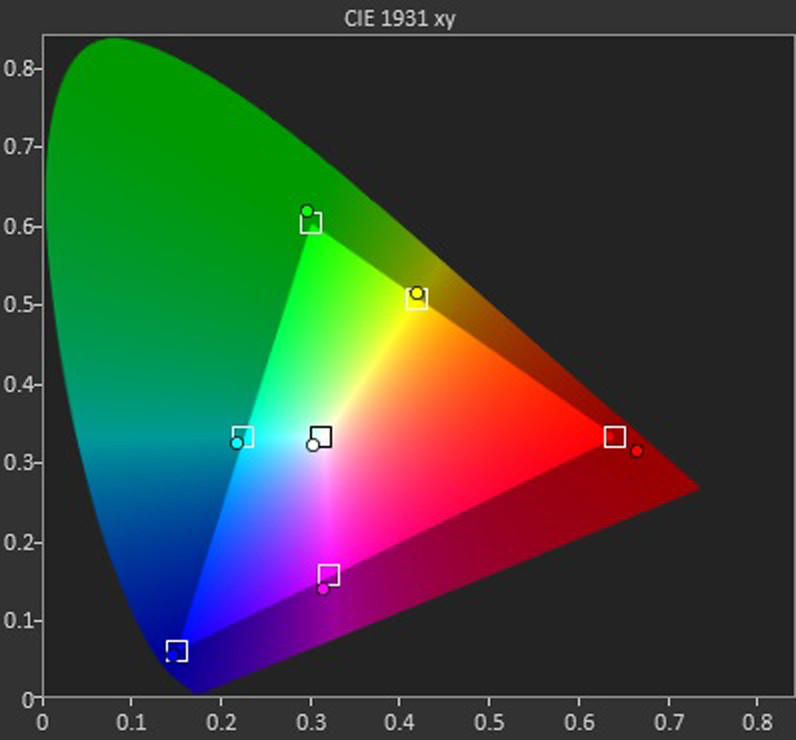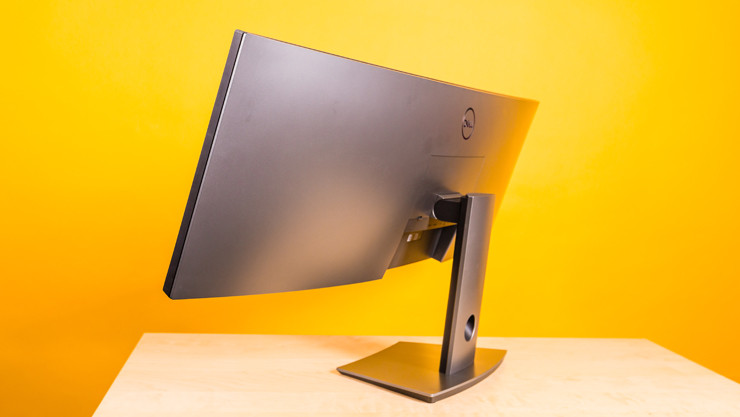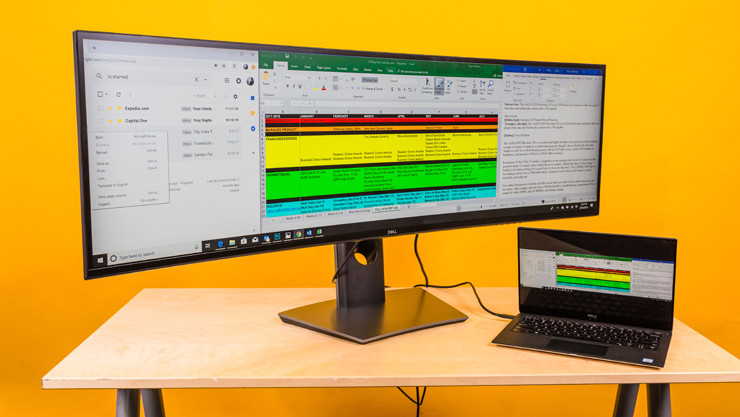In the wake of Samsung’s release of its CHG90 49-inch ultra-wide gaming monitor and its 2019 follow-on, the CRG9, other monitor makers have been announcing massively wide monitors of their own, though few have yet come to market. We got our hands on Dell’s UltraSharp 49 Curved Monitor (U4919DW), put it through its paces, and were not disappointed. On sheer size, this feature-packed 49-inch panel is a thing of wonder, and it performs well. It’s a top choice, ironically, not for gamers or video hounds but productivity workers who need to have lots of windows visible onscreen at the same time, side by side. If you have the space and executive-size desk for this huge panel, and the deep budget to pay for it, it’s a worthwhile investment. But other, more economical alternatives may prove more appealing to you.
Similar Products
This 49er Is an Ultrawide Receiver
The heart of the U4919DW is its 49-inch (measured on the diagonal) ultra-wide screen. The panel employs in-plane switching (IPS) technology, which is known for its color accuracy and wide viewing angles from offsides, above, and below.
Including the stand, the monitor weighs a lusty 58 pounds. You will want two people to move it into place, as much due to the U4919DW’s overall width (48 inches) as its weight. Carrying it reminded me of lugging around a piece of lumber; if you’re not careful, the front end can swing to either side.

The monitor sits on a stand with a sturdy base that takes up a substantial (10-by-14-inch) footprint. The stand has some ergonomic chops, supporting 3.5 inches of height adjustment, and 26 degrees in tilt adjustment. Also, it’s set on a ring that can rotate up to 170 degrees in either direction.
A Tale of Two Giants
Although they are visually similar and their screens have the same size and aspect ratio, there are some important differences between the business-oriented U4919DW and another pioneering 49-inch monitor, the Samsung CHG90, which is built for gaming.
The U4919DW’s resolution is much higher—5,120 by 1,440 pixels, as opposed to 3,840 by 1,080 for the Samsung. This means that the U4919DW has a higher pixel density, 106 pixels per inch (ppi), compared with 81ppi for the Samsung. Too low a pixel density can affect image sharpness. Text and photos rendered by the CHG90 were not particularly sharp, but the U4919DW handled both well. The native resolution of 5,120 by 1,440 is functionally equivalent to two 1440p (2,560 by 1,440) displays, side by side in one enclosure.

The word “curved” appears in the U4919DW’s name, and the panel is indeed gracefully swooping, with a 3800R curvature rating. This means that if you were to place enough U4919DW monitors side by side to form a circle, it would have a radius of 3,800mm, or 3.8 meters. This amount of curvature is modest compared with the Samsung CHG90’s wickedly curved screen, which has an 1800R ratio, one of the tightest we have seen. Combined with the panel’s ultra-wide form, 1800R provides for an immersive gaming experience.
Gray-to-gray pixel response for the U4919DW in its fast mode is 5 milliseconds, and input lag—as measured with a Leo Bodnar Lag Tester—came in at an impressively low 9 milliseconds. The panel performed well when I ran Far Cry 5 and Rise of the Tomb Raider from our Windows 10 testbed equipped with an Nvidia GeForce RTX 2080 Founders Edition card, with no significant artifacts.
But although it is fine for casual gaming, the U4919DW’s refresh rate is a mere-mortal 60Hz, and it lacks adaptive sync technology to reduce tearing and other artifacts. The CHG90’s refresh rate, in contrast, is a blazing 144Hz, and the monitor employs FreeSync 2, the latest iteration of AMD’s adaptive sync spec. The U4919DW also lacks support for HDR output, unlike the CHG90.
A Profusion of Ports and Controls
The connectors on the U4919DW comprise two HDMI 2.0 ports, two upstream and five downstream USB ports, one DisplayPort 1.4 port, and a USB Type-C port. You can use the last one to charge or power devices while the USB-C can also transfer data over the cable.

My personal laptop is a Dell XPS 13, which includes a USB Type-C port. Bringing my XPS 13 into work while I have been testing the U4919DW, I haven’t needed to tote along its power adapter. I can just connect the laptop via a USB-C cable to the monitor, which supports the USB power delivery (USB-PD) protocol. In this case, that allows for high-speed charging with power delivery of up to 90 watts while receiving data over a single cable.
The U4919DW’s USB Type-C connection also allows for a further trick: a virtual keyboard/video/mouse (KVM) switch. You can easily control two different PCs connected to the U4919DW, so long as one is connected to the monitor’s USB-C port. That would let you share the ample screen real estate, while employing a single keyboard and mouse. You can even allocate part of the screen to one PC’s display input and part to another’s (what Dell calls “picture by picture,” here) and show both windows onscreen at the same time. That’s a nifty perk.

The physical controls comprise six tiny buttons on the bottom edge of the panel, a little to the right of center. They’re a far cry from the mini-joystick-style menu controller you often find on hardcore gaming monitors, but they’re not hard to learn and operate.
The one furthest to the left is the on/off button, while the other five let you navigate the onscreen display. From the Preset Modes button setting, to the right of the on/off button, you can switch among modes such as Standard, ComfortView, Movie, Game, Color Temperature, and Custom Color.
The next button over lets you control brightness and contrast, with sliders for each. The fourth lets you choose an input source (the two HDMI ports, DisplayPort, USB-C, or Auto-Select). The fifth offers a menu to access all the settings listed here plus some additional ones, while the final button lets you cancel a command.
Dell backs the U4919DW with a three-year warranty.
Color and Brightness Testing
We measured the U4919DW’s brightness, contrast ratio, and color accuracy using our Klein K10-A colorimeter and SpectraCal CalMAN 5 software. I measured the brightness in Standard mode at 253 nits, well below its rated 350-nit brightness but still a reasonable figure for general business use. I additionally measured its black level and calculated a contrast ratio of 1,265:1, better than its 1,000:1 rating.

Above is a color accuracy or chromaticity chart, which was generated when testing in standard mode. The area within the triangle represents all the colors that can be made by mixing the primary colors red, green, and blue. The circles, representing our measurements, lie just outside the triangle and are fairly evenly spaced, indicating a slightly expanded color gamut.
There’s nothing quite like the U4919DW on the market today, but that will change soon. At CES 2019, LG announced a 49-inch monitor with very similar specs, and as mentioned above, Samsung will be coming out with an upgrade to the CHG90 that will match the U4919DW’s resolution while retaining the CHG90’s gaming bent.

Multitasking Heaven, at a Devil of a Price
The UltraSharp 49 Curved Monitor (U4919DW) is sure to delight multitaskers. This 49-inch business monitor lets you view multiple windows at once, so you could, for example, view your Slack feed and glance at your email while working on a spreadsheet. The possibilities and combinations are endless. The Dell Display Manager software’s Easy Arrange feature lets you easily split your screen into up to six windows. This IPS panel is bright and renders color very well, and you get a host of connection choices.
A potential deal-breaker is the U4919DW’s hefty price. Even discounted off of MSRP at this writing, it was costly. You could opt for the Samsung CHG90 and still spend hundreds less. The tradeoff for the savings is the lower native resolution and correspondingly lower pixel density of that gaming-centric monitor, which could adversely affect image quality. True to its UltraSharp moniker, the U4919DW rendered sharper images in our testing than we saw with the CHG90.

Another much cheaper alternative to the Dell UltraSharp is not one big monitor but a dual-monitor array. Dell describes the U4919DW as “…equivalent to two 27-inch dual QHD monitors without the bezel in between…” You could, for instance, take two Editors’ Choice ViewSonic VP2768 27-inch QHD monitors, which have ultra-thin bezels, and yoke them together for about $ 720, almost a grand less. (The VP2768 is a low-priced professional monitor whose forte is color accuracy.) That, or a similar pairing of 27-inch 1440p panels, might be preferable if your workspace is tight or if you would rather have two monitors than one gigantic one. But if the idea of one huge, wide, business-oriented panel appeals to you, the U4919DW is a good choice, if you’ve got the bucks.








